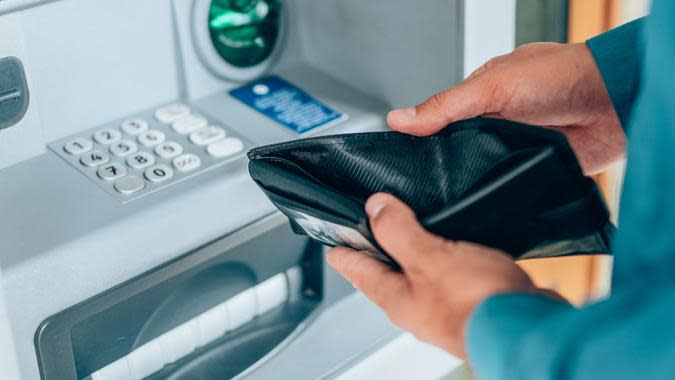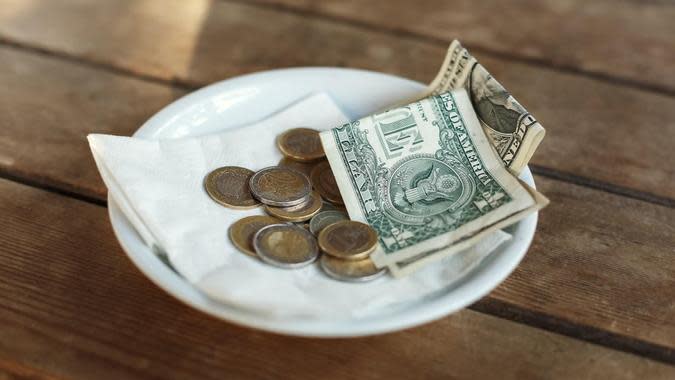30 Expenses That Quietly Eat Away at Your Budget

You can’t fail to notice the big bills your paying each month, like your monthly mortgage or car payment, but expenses that are smaller and easier to miss can sneak past and pile up.
Check Out: 5 Unnecessary Bills You Should Stop Paying in 2024
Try This: 6 Genius Things All Wealthy People Do With Their Money
“Nickels and dimes add up to dollars, and $5 and $10 add up to hundreds and eventually thousands,” said Robert Clements, CHFC, AIF, partner at FRS Advisors in Wayne, Pennsylvania. “Spend the time tracking and evaluating your expenses and budget no less than two times a year, and I promise, it will benefit you.”
Here’s a look at the sneaky expenses that nibble away at your budget.

Overlapping or Underutilized Insurance Policies
Griffith E. Harris, Jr., president and owner of Griffith E. Harris Insurance Services, said he’s seen unused insurance policies drain budgets.
“Often, people are not aware they’re paying for overlapping coverages across different policies, such as travel insurance benefits that might already be covered under certain premium credit cards,” he said.
Read Next: 10 Expenses Most Likely To Drain Your Checking Account Each Month
Learn More: I’m a Frugal Shopper: 7 Things I Never Waste Money On
Sponsored: Credit card debt keeping you up at night? Find out if you can reduce your debt with these 3 steps

Financial and Investment Subscriptions
Mike Kojonen, founder and owner of Principal Preservation Services, said people often subscribe to investment or financial research services and tools that go unused and forgotten.
“Many sign up for these services with the intention of using them to make informed financial decisions,” he said. “Yet the daily demands of life mean that these subscriptions go underutilized.”
Trending Now: How Far a $100,000 Salary Goes in America’s 50 Largest Cities

ATM Fees
Kojonen said, “Bank fees, while they seem nominal on a per-item basis, can accumulate to a substantial amount over time.”
He cited ATM fees, specifically, which generally fall between $2.50 and $5.

Bank Maintenance Fees
Kojonen also called out monthly maintenance fees, which are still common on some checking accounts. According to Experian, they average between $5 and $35 per month.

Overdraft Fees
While many banks have done away with overdraft fees, some still charge them, according to Kojonen. The FDIC says the average is $35 per transaction.

Cable TV
Your TV habit might be bleeding you slowly, too.
“Cable has gotten more expensive, so review if it is worth ‘cutting the cord’ and eliminating that expense, which can be hundreds a month,” said Clements.
According to a study from Allconnect, cable packages can cost as much as $299.95 per month without fees or internet service.
Explore More: 11 Free TV Apps That’ll Let You Cut the Cable

Overlapping or Unused Streaming Services
According to Forbes, the average American spends $46 per month on streaming services, and many are paying for platforms they don’t use.
“When it comes to budget vampires, it’s hard to beat unused subscriptions,” said Jake Hill, CEO of DebtHammer Consolidation. “These small, auto-pay bills are so easy to forget about, but they quickly add up over the course of a year.”

Brand-Name Prescription Drugs
Lynnette Khalfani-Cox, “The Money Coach,” a former award-winning financial journalist and Wall Street Journal reporter for CNBC, cited CDC data showing that 60% of Americans take prescription medicines, spending an average of $1,200 annually.
“You can slash this cost by 70% by switching from brand name to generic drugs,” she said. “And don’t worry: You’re not sacrificing your health. By law, generics must contain the identical active ingredients as brand-name medications. The only difference is the price tag. Making this one easy switch could save you $840 per year.”

Unused Gym Memberships
According to Renee McBride, personal finance author at Net Pay Advance, “Many people sign up for gym memberships with the best intentions but end up not utilizing them. If you’re not getting your money’s worth, consider canceling or downgrading to a more cost-effective option.”
According to GoodRx, the average gym membership costs $40 to $70 per month.

Impulse Purchases
McBride said to avoid “small, spontaneous purchases” that might seem insignificant individually but can add up over time.
“Practice mindful spending and consider whether each purchase aligns with your financial goals,” she said.
Find Out: 6 Things Minimalists Never Buy — and You Shouldn’t Either

Food Delivery Fees
According to UpMenu, typical food delivery fees range from $2 to $5 per order, but can be higher for longer distances or peak hours.

Convenience Charges
McBride said to be cautious with takeout and other deliveries, which often come with fees on top of standard delivery charges.
“While convenient, these fees can accumulate over time,” she said. “Plan ahead to minimize these expenses where possible.”

Pre-Made Food
The grocery store is another place where the cost of convenience adds up.
“Packaged, processed foods at the grocery store cost about 25% more compared to buying basic, healthy ingredients,” said Khalfani-Cox. “Swapping out pre-made frozen meals and packaged snacks for whole foods like grains, proteins, fruits and vegetables could save a family of four around $1,500 per year.”

Mobile Service From a Major Carrier
Khalfani-Cox said that most Americans buy a new phone every two or three years.
“Instead of purchasing a $1,000 smartphone, switch from regular post-paid phone service to a prepaid phone,” she said. “Straight Talk Wireless has affordable prepaid phones and no-contract plans as low as $25 a line. Swap into their family plan for the best value and save $960 a year.”
Discover More: 4 Best Cable TV and Internet Options to Better Fit Your Budget

Fitness Apps
Rhett Stubbendeck, CEO and founder of the financial planning site Leverage, said he sees people subscribe to fitness apps, which often go unused when motivation dwindles.
“I believe that you should take a moment to review your subscriptions monthly and consider which ones you truly value and use regularly,” he said.

Credit Card Finance Charges
With the average credit card APR approaching 28%, according to Forbes, now is no time to maintain a revolving balance.
“Carrying a balance on your credit card can result in hefty interest charges,” said McBride. “Paying off your balance in full each month can help you avoid these unnecessary expenses.”

Credit Card Transaction Fees
Businesses pay between 1.5% and 3.5% for credit card transaction fees. Many compensate by passing those fees on to consumers, although they’re limited to 4%.

Wasted Food
According to Ohio State University, Americans waste roughly one-third of the food they buy, totaling about $1,500 annually per four-person household.
“My top tips to prevent food waste are to meal plan, check ingredients before you shop and learn what can be frozen and how to freeze it,” said Carter Seuthe, CEO of Credit Summit Consolidation.
Learn More: I’m a Shopping Expert: 9 Items I’d Never Put in My Grocery Cart

Anything on Auto-Renew
From Amazon Prime to your favorite wellness app, you should periodically review anything that re-subscribes you automatically as prices, policies and services change.
“These small expenses add up quickly, especially since they are set to auto-renew,” said Ann Martin, director of operations of CreditDonkey. “To reclaim more of your income, take the time to thoroughly review all of your active subscriptions.”

Sales Tax
Most states charge between 5% and 7% in sales tax, a perpetual expense that adds up to thousands over time. According to the Urban Institute, 18 states have sales tax holidays at the end of summer for back-to-school shopping. If you live in one, cram as many purchases into your state’s tax holiday as possible.

Vampire Appliances
Unplug so-called vampire appliances, which draw energy even when they’re not in use, like hair dryers, coffee makers and laptops. According to the Department of Energy, each vampire appliance can cost you $100 to $200 per year.

Gratuity
You might notice that you’re being asked to tip for just about everything nowadays, with some kiosks and POS devices defaulting to 30% gratuity for things like takeaway coffee. Kiplinger calls it “tipflation,” and if you cave into the pressure and tip without thinking, everything will cost more.
Find Out: Here’s What the US Minimum Wage Was the Year You Were Born

Unused Lighting
According to Mr. Electric, lighting accounts for 20% of home energy spending, or about $200 per year for the average household.
“How about your energy costs?” said Clements. “Are you leaving your holiday lights on through the night? Can you eliminate a few hours a day that way? Are you — or most likely your kids — leaving the lights in the house on in every room, like mine?”

Ticket Service Charges
Anyone who buys tickets to concerts or sporting events is all too familiar with one of the most reviled up-charges in America. Service charges from companies like Ticketmaster can increase the price of a ticket by 27% to 30%.

Fuel Surcharges
Airlines and even some rideshare services add a charge to compensate for fuel costs. Uber tacks on $0.45-$0.55 per ride, and, according to Forbes, fuel surcharges can add $500 to the price of airfare from New York to London.

Restaurant Inflation Fees
Many restaurants have responded to rising prices by tacking so-called inflation fees onto diners’ bills. According to CNBC, they cover everything from health insurance to tap water and typically range between 3% and 5% of the bill.
Check Out: 8 Aldi Meals That Are Cheaper Than Buying Takeout

Investment Fees
Fees attached to your 401(k), mutual funds and ETFs can eat away at your investment returns — and a little can go a long way in shrinking your nest egg. According to Reader’s Digest, a seemingly modest 1% fee can rob 28% of your retirement balance.

Resort Fees
Some hotels charge so-called resort fees, destination fees or urban fees, which the New York Times calls “among the most loathed in the travel realm.” They average $26 per night, and hotels use them to keep their published rates lower.

Balance Transfer Fees
Transferring high-interest balances to a card with a 0% introductory rate is one of the best ways to put a revolving balance on ice — but it’ll cost you. According to Forbes, balance transfer fees are usually 3% to 5% of the balance.

Utilities and Lost Energy
According to Forbes, the average household now pays $429.33 per month, or $5,151.96 per year, for utilities. While that’s an essential bill, it doesn’t have to be so high. Conduct an in-home energy audit or hire a professional to do it for you so you can identify opportunities to save money.
“Upgrading to more energy-efficient options can require an initial investment but leads to noteworthy savings in the long term,” said Kojonen. “This is a specific case where upfront costs can lead to long-term savings, helping to alleviate financial pressures in retirement years.”
More From GOBankingRates
This article originally appeared on GOBankingRates.com: 30 Expenses That Quietly Eat Away at Your Budget

 Yahoo Finance
Yahoo Finance 